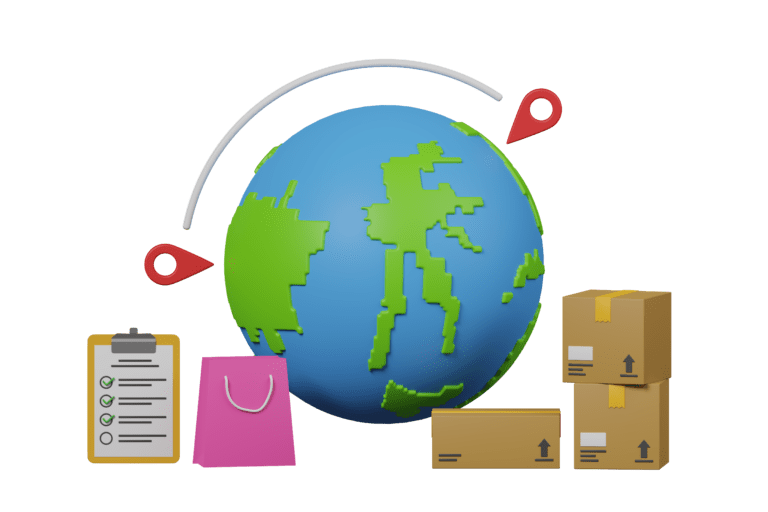In the vast world of online shopping, Amazon reigns supreme. It’s the go-to destination for millions of consumers seeking a vast array of products delivered conveniently to their doorsteps. Amazon shipping costs play a pivotal role in the success of this e-commerce giant. However, have you ever stopped to ponder, “How much is Amazon shipping?” The answer to this question holds significant implications for both buyers and sellers.
For Buyers:
Understanding Amazon shipping costs is crucial because it directly impacts your shopping experience. Whether you’re an occasional Amazon shopper or a frequent buyer, knowing the ins and outs of shipping fees can help you save money, expedite deliveries, and make informed choices when choosing Amazon Prime or opting for alternative shipping methods. Unpacking the cost structure behind Amazon’s shipping policies allows you to shop smarter, ensuring that the convenience of e-commerce doesn’t come at an unexpected premium.
For Sellers:
Amazon shipping costs aren’t just a concern for buyers; they’re also a critical factor for sellers. If you’re an e-commerce entrepreneur or an established business looking to tap into Amazon’s vast customer base, you must navigate the intricate web of shipping fees. Understanding how Amazon’s shipping system works is paramount to setting competitive prices, maximizing your profitability, and ensuring a positive customer experience. It’s not just about the dollars and cents; it’s about maintaining a thriving online business in a competitive marketplace.

Amazon Shipping for Buyers
Amazon Prime is the golden ticket to a world of convenience for online shoppers. This premium subscription service offers an array of benefits that go far beyond just free shipping.
Benefits of Amazon Prime:
- Free and Fast Shipping: The primary allure of Amazon Prime is the promise of free two-day (or even one-day) shipping on eligible items. This means that as a Prime member, you can receive your orders faster than standard shipping times.
- Prime Video: In addition to shipping perks, Amazon Prime membership includes access to Prime Video, an extensive library of movies, TV shows, and exclusive content. It’s like having a streaming service bundled with your subscription.
- Prime Music: Prime members also get access to Amazon Prime Music, a music streaming service with over two million songs. You can enjoy ad-free music and even download songs for offline listening.
- Kindle Owners’ Lending Library: If you’re a Kindle owner, you can borrow e-books from the Kindle Owners’ Lending Library, giving you access to a wide selection of e-books at no additional cost.
Subscription Fees:
Amazon Prime’s benefits come at a cost. Amazon offers two main subscription plans:
- Annual Subscription: $99 per year. This is the most cost-effective option for those who intend to use Prime throughout the year.
- Monthly Subscription: $9.99 per month for those who prefer a more flexible commitment. While it may be a bit more expensive on a month-to-month basis, it doesn’t require a long-term commitment.
Please note that subscription fees may change over time, so it’s essential to check the current pricing on Amazon’s official website. Understanding the cost and benefits of Amazon Prime is fundamental to deciding whether this service aligns with your shopping habits and preferences.
Non-Prime Shipping Costs
For those who haven’t subscribed to Amazon Prime, it’s essential to understand how non-Prime shipping costs work. Amazon offers various shipping methods, and the fees associated with these methods can vary depending on several factors.
Calculating Shipping Costs:
Non-Prime members can calculate their shipping costs during the checkout process. Here’s a breakdown of the key factors that contribute to the final shipping fee:
- Shipping Method: Amazon provides various shipping options, such as Standard Shipping, Two-Day Shipping, and One-Day Shipping. The cost increases with the speed of delivery you choose.
- Shipping Address: Your shipping destination plays a significant role in determining the cost. Amazon may charge different rates for deliveries to different regions or countries.
- Item Size and Weight: The size and weight of the items you’re ordering have a direct impact on shipping costs. Larger and heavier items typically incur higher shipping fees due to the increased resources required for transportation.
- Order Total: Some shipping costs may be influenced by the total value of your order. Amazon occasionally offers free shipping on eligible orders over a certain threshold, which can be an attractive option for cost-conscious shoppers.
- Special Requirements: If you need specialized shipping options, such as scheduled delivery or delivery to a specific location within your residence, additional fees may apply.
Understanding these factors allows non-Prime members to make informed decisions when selecting their preferred shipping method. It’s worth noting that while Amazon offers various shipping options, free shipping for non-Prime members is typically available for eligible orders, but it may not be as fast as Prime shipping.
Amazon Shipping for Sellers
Sellers on Amazon have their own set of considerations and options when it comes to shipping. One of the most prominent programs for sellers is Fulfillment by Amazon (FBA).
Fulfillment by Amazon (FBA)
Fulfillment by Amazon (FBA) is a comprehensive solution for Amazon sellers looking to streamline their operations, reach a broader customer base, and provide hassle-free shipping for their products. Here’s how FBA works and what sellers should know about its associated fees:
How FBA Works:
FBA allows sellers to store their products in Amazon’s fulfillment centers. When a customer places an order, Amazon takes care of everything, from picking and packing the product to shipping it to the customer’s doorstep. Here’s an overview of the process:
- Send Your Products: Sellers send their products to Amazon’s fulfillment centers. Amazon stores the products in their warehouses until they are sold.
- Customer Orders: When a customer places an order for your product, Amazon’s team takes care of picking the product from the warehouse, packing it, and shipping it to the customer.
- Customer Service and Returns: Amazon also handles customer service and returns related to FBA orders, providing a seamless experience for buyers.
FBA Fees:
While FBA offers numerous benefits, sellers should be aware of the associated fees:
- Storage Fees: Amazon charges storage fees for the space your products occupy in their fulfillment centers. These fees can vary based on the time of year and the volume of products stored.
Month | Standard size | Oversize |
January – September | CAD $33 per cubic meter | CAD $23 per cubic meter |
October – December | CAD $53 per cubic meter | CAD $34 per cubic meter |
- Fulfillment Fees: This fee covers the cost of picking, packing, and shipping your products. It’s influenced by the size and weight of the item, as well as the shipping method chosen by the customer. Complete list of Fulfillment fees.
- Long-Term Storage Fees: If your products remain in Amazon’s fulfillment centers for an extended period, you may incur long-term storage fees.
- Removal or Disposal Fees: If you decide to remove your products from FBA or have them disposed of, Amazon will charge fees for these services.
FBA fees can fluctuate, so it’s essential to regularly review Amazon’s fee structure to understand the cost implications for your business. Sellers should weigh these fees against the advantages of FBA, such as Prime eligibility and improved shipping reliability, to make informed decisions regarding their fulfillment strategy.
Seller-Fulfilled Shipping
While Fulfillment by Amazon (FBA) is a popular choice for many sellers, some prefer to handle their own shipping logistics. Seller-fulfilled shipping offers greater control but comes with its own set of responsibilities and considerations.
Understanding Seller-Fulfilled Shipping:
Seller-fulfilled shipping means that the seller takes on the responsibility of packing and shipping orders directly to customers. Here’s how it works:
- Packing and Shipping: As a seller, you are responsible for packaging your products and selecting the shipping method. This allows for more flexibility in how you fulfill orders.
- Order Management: You’ll need to monitor your orders, print shipping labels, and ensure timely delivery. This can be done using Amazon’s seller tools or through third-party shipping services.
- Customer Service: Seller-fulfilled orders also require you to handle customer inquiries, returns, and any shipping-related issues directly.
Calculating Shipping Costs for Seller-Fulfilled Orders:
To calculate shipping costs when using the seller-fulfilled shipping method, you’ll need to consider the following factors:
- Shipping Method: The shipping method you choose will have a significant impact on the cost. Options range from standard shipping to expedited services, each with its own price point.
- Shipping Carrier: Your choice of shipping carrier (e.g., USPS, FedEx, UPS) will affect shipping costs. Different carriers have varying rate structures and service levels.
- Package Size and Weight: The dimensions and weight of your packages play a crucial role in determining shipping costs. Heavier and bulkier items may incur higher fees.
- Shipping Distance: The distance between your location and the customer’s address influences shipping costs. Longer distances typically result in higher fees.
- Shipping Speed: Faster delivery options, such as next-day or two-day shipping, are usually more expensive than standard shipping.
- Shipping Zones: Shipping rates may differ based on zones or regions. Some carriers use a zoning system to determine pricing.
- Shipping Insurance: If you choose to add insurance to protect against loss or damage, this will be an additional cost.
For sellers opting for this method, it’s crucial to have an efficient shipping process in place. Calculate your shipping costs accurately to ensure you’re pricing your products competitively while covering your expenses. Using shipping calculators and working with shipping carriers can help streamline this process.
Strategies to Save on Amazon Shipping
Amazon shoppers often look for ways to save on shipping costs. Here are some strategies that buyers can employ to make the most of their Amazon shopping experience:
For Buyers
- Bundle Your Orders:
Consider bundling multiple items into a single order. This can help you qualify for free shipping if your order total meets the minimum threshold required for free shipping eligibility. Plus, it reduces the number of shipments, which is environmentally friendly and may lead to fewer shipping costs overall.
- Use No-Rush Shipping:
When making a non-urgent purchase, select the “No-Rush Shipping” option during checkout. In return for a slightly longer delivery window, Amazon often rewards you with promotional credits, like discounts on future purchases, which can add up over time.
- Subscribe and Save:
If you regularly purchase the same items, consider using Amazon’s “Subscribe & Save” program. This feature allows you to schedule automatic deliveries at a reduced price, and you may benefit from free shipping on these subscription orders.
- Check for Amazon Prime Deals:
Keep an eye out for Amazon Prime exclusive deals, where Prime members can access special discounts and promotions, often with free, fast shipping.
- Amazon Day:
Use Amazon Day if you are a Prime member. It allows you to schedule your deliveries for a specific day each week, reducing the number of shipments and potentially lowering your shipping costs.
By employing these strategies, Amazon shoppers can enjoy cost savings and a more efficient shopping experience, making the most of their online purchases while being mindful of shipping expenses.
For Sellers
As an Amazon seller, optimizing shipping costs is a vital aspect of running a successful and profitable business. Here are strategies to help sellers effectively manage their shipping expenses:
- Utilize FBA Cost Calculators:
For sellers using Fulfillment by Amazon (FBA), Amazon provides cost calculators that allow you to estimate your fulfillment and storage costs. By regularly using these tools, you can plan your pricing strategies, inventory levels, and product selection to minimize your overall expenses. Calculators take into account factors such as storage duration, product size, and shipping volume, enabling you to make data-driven decisions.
- Consider Multi-Channel Fulfillment:
Amazon offers Multi-Channel Fulfillment, allowing you to use FBA to fulfill orders from other sales channels, not just Amazon. This can help you maximize the utilization of your FBA inventory and take advantage of Amazon’s efficient fulfillment services.
- Optimize Your Packaging:
Efficient packaging can significantly impact your shipping costs. Properly size and package your products to reduce dimensional weight charges and minimize the use of excess packaging materials. This not only saves on shipping fees but also contributes to sustainability efforts.
- Leverage Amazon’s Shipping Tools:
Amazon provides various tools and resources to help sellers streamline their shipping operations. Use services like Amazon Partnered Carrier, which offers discounted shipping rates, and Seller-Fulfilled Prime to gain Prime eligibility for your products without using FBA. Additionally, monitor your seller dashboard for valuable insights into your shipping performance and customer satisfaction.
- Evaluate Shipping Promotions:
Consider offering free shipping or discounted shipping on selected items to attract more customers. While this may reduce your immediate profit margins, it can lead to increased sales volume and overall profitability.

International Shipping on Amazon
Expanding your market reach to international customers can be a lucrative strategy. Here’s how international shipping on Amazon works and the associated considerations:
How International Shipping on Amazon Works:
Amazon facilitates international shipping through its Global Export and Import (GXI) program. This program allows sellers to offer their products to customers around the world, extending their potential customer base significantly.
To enable international shipping, sellers can opt to include their products in Amazon’s global listings, making them available to customers in various countries. When an international customer places an order, Amazon helps facilitate the export and import processes, ensuring a smooth transaction.
Additional Costs and Considerations:
Expanding into international markets presents sellers with a range of new considerations and potential costs:
- Shipping Costs: International shipping typically incurs higher costs than domestic shipping. Sellers need to calculate and account for these expenses when pricing their products.
- Customs and Duties: Customers may be subject to customs fees and import duties. It’s crucial to inform international buyers about potential additional charges and be prepared to assist them with related inquiries.
- Regulations and Compliance: Different countries have varying regulations regarding product standards, labeling, and certifications. Sellers should research and adhere to these requirements to ensure successful international sales.
- Currency Conversion: Transactions may involve currency conversion, which can impact the final amount received. Consider offering multiple currency options to make the shopping experience more transparent for international buyers.
- Shipping Time: International shipments may take longer to reach their destination, which could affect customer satisfaction. Communicate estimated delivery times clearly to manage expectations.
- Customer Support: Providing effective customer support for international buyers, including addressing language barriers, is essential for a positive customer experience.
Expanding into international markets can be a lucrative endeavor, but it requires thorough research, preparation, and a willingness to adapt to the unique challenges of global e-commerce. Sellers who successfully navigate international shipping can access a broader customer base and potentially increase their revenue substantially.
Comparison with Other E-commerce Platforms
When considering Amazon’s shipping costs, it’s valuable to compare them with other popular e-commerce platforms like eBay and Walmart. Each platform has its own shipping policies and cost structures, which can influence a shopper’s decision-making process.
Amazon:
- Amazon Prime: Amazon offers Prime membership, providing subscribers with free and fast shipping on eligible items, along with additional benefits like streaming services. Non-Prime members can incur shipping costs based on factors like shipping method, item size and weight, and destination.
- Fulfillment by Amazon (FBA): Sellers can choose FBA for efficient, Prime-eligible shipping but are subject to associated fees like storage and fulfillment costs.
eBay:
- Shipping Costs Vary by Seller: On eBay, shipping costs are set by individual sellers, and they can vary widely. Some sellers offer free shipping, while others charge based on factors like item weight, size, and the buyer’s location.
- eBay Plus: In some regions, eBay offers a premium service called eBay Plus, which provides members with free shipping on eligible items and other benefits, similar to Amazon Prime.
Walmart:
- Walmart+: Walmart offers a subscription service called Walmart+, which includes free delivery on eligible orders. This service is similar to Amazon Prime and is available for a monthly or annual fee.
- Standard Shipping: Non-members may incur shipping costs that vary based on factors like order total, delivery speed, and the seller’s location.
Comparing Amazon, eBay, and Walmart:
- Amazon Prime and Walmart+ are subscription services that offer fast and free shipping on eligible items. These services come with an annual or monthly fee.
- eBay’s shipping costs depend on individual sellers, which means shoppers may encounter a wider range of shipping fees and policies.
- All three platforms provide some form of free shipping option for certain orders, but the specific criteria and benefits can vary.
- While shipping costs are a significant consideration, factors like product availability, customer service, and the overall shopping experience also play a role in a shopper’s choice of platform.
Conclusion
Understanding Amazon shipping costs is a fundamental aspect of navigating the world of online shopping and e-commerce. It empowers both buyers and sellers to make informed decisions, optimize their experiences, and control their expenses. By considering the various options, strategies, and costs associated with Amazon shipping, you can leverage this knowledge to your advantage, ensuring a smoother and more cost-effective journey in the realm of e-commerce. So, the next time you click “Add to Cart” or list your products, remember that understanding Amazon shipping costs is your key to a successful and satisfying e-commerce experience.
Ready to optimize your shipping as a seller? ShipShop is here to help you navigate the intricate world of e-commerce logistics.
Partner with ShipShop to streamline your e-commerce operations. Whether you choose Fulfillment by Amazon (FBA), self-fulfillment, or want to explore multi-channel fulfillment, our comprehensive shipping and logistics tools can help you calculate costs, optimize your packaging, and expand your reach to international markets. Let ShipShop be your trusted shipping partner.
We’re here to simplify the complex world of e-commerce logistics and empower you to make informed decisions. Don’t miss out on the opportunity to save time, money, and resources. Join ShipShop today and embark on a journey towards efficient, cost-effective, and hassle-free shipping.
FAQ
Are there alternatives to Fulfillment by Amazon (FBA) for sellers?
Yes, sellers can use Multi-Channel Fulfillment or Seller-Fulfilled Prime to leverage Amazon’s shipping services without using FBA. They can also explore third-party fulfillment services or self-fulfillment.
How can I calculate my shipping costs as a seller on Amazon?
Sellers can calculate their shipping costs using Amazon’s FBA cost calculators or by considering factors such as shipping method, package size and weight, and shipping distance for seller-fulfilled orders.

Q & A
Visit our FAQ section to see answers to some of our most asked questions.

Let's Chat
Need help? Shoot us a message or find out more about us and how we can help your business grow.
Shop the Best Shipping Rate with ShipShop
Sign Up for free today!

